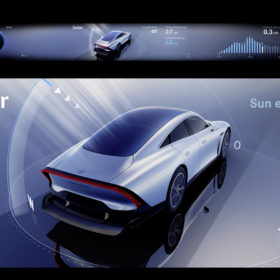Video: TNO expert discusses outlook for future development of solar vehicles
Bonna Newman, program manager at TNO, speaks to pv magazine about the road forward for vehicle-integrated PV, which will likely remain a niche over the short term, despite recent industrial developments. Several companies have started production, but high-volume output and the potential of other PV technologies beyond crystalline silicon remain key challenges for the future of vehicle-integrated solar.
Vehicle-integrated solar kit may reduce frequency of recharging by 14%
Developed by the French research institute Liten, the prototype kit consists of a 145 W photovoltaic panel, a magnetic rear panel, and an MPPT charge controller. It also includes a battery and a micro-inverter that can be used to inject the stored energy into the grid when the vehicle is recharged.
Vehicle-integrated photovoltaics for low-speed electric vehicles
Canadian startup Capsolar claims its flexible solar modules can be adapted to any type of low-speed electric vehicle with no extra modification and custom work. The panels have an efficiency of 21.3%.
Printed solar panels for Tesla’s journey around Australia
Commercially printed solar cell technology developed by the University of Newcastle is being put to the test to power an electric vehicle’s 15,097-kilometre journey around the entire coastline of Australia.
New solar trailer bus from Sono Motors
The municipal bus fleet in Munich, Germany, will soon be equipped with solar-powered trailer units.
Hyundai Sonata hybrid is equipped with a solar roof
The 205W PV array adds nearly 1,000 miles of range each year and helps prevent battery discharge events that are responsible for four out of every ten roadside emergency breakdowns.
Solar caravan powering the electric vehicle that tows it
The solar modules for the solar array were supplied by Chinese manufacturer Longi, which is a major partner in the project.
Mercedes’ newest electric car comes with thin crystalline solar cells on the roof
The solar roof was developed in collaboration with the Fraunhofer Institute for Solar Energy Systems.
Your next package delivery could be solar powered
There is still much to debate over the benefits of moving a vehicle via solar, but the market has been getting creative and is evolving quickly.
Solar-powered delivery van with 400 km range
Swedish start-up Clean Motion is seeking to commercialize an electric delivery van that is also powered by IBC solar modules placed on its roof. The vehicle is claimed to have a 400 km range, of which up to 130 km are provided by the PV array.










